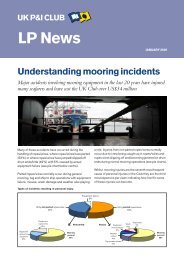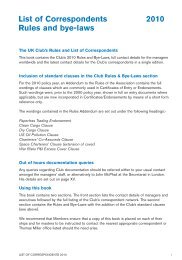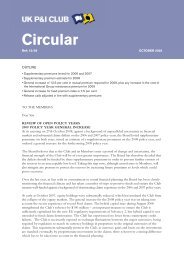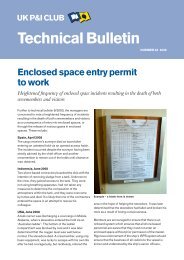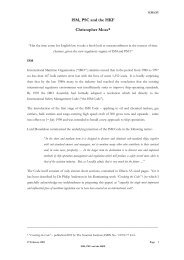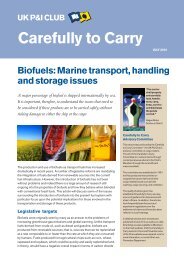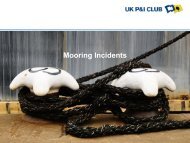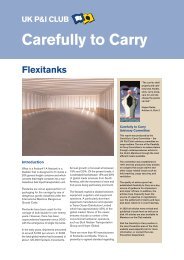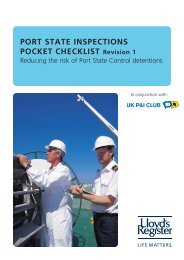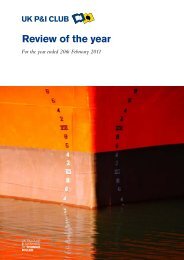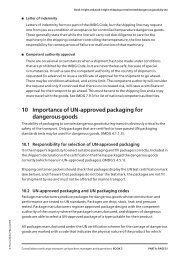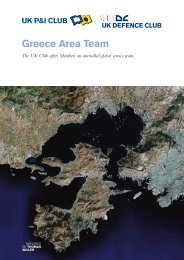Bulk Matters - UK P&I
Bulk Matters - UK P&I
Bulk Matters - UK P&I
Create successful ePaper yourself
Turn your PDF publications into a flip-book with our unique Google optimized e-Paper software.
sweat damage under some circumstances is inevitable.<br />
It will be seen from the foregoing sections that moisture<br />
migration within, and from, a water-holding cargo must<br />
occur as the vessel moves through different<br />
climatological regions. The purpose of ventilation is to<br />
minimise damage to the cargo resulting from this<br />
moisture migration. However, it will also be seen that<br />
such ventilation cannot always be completely effective<br />
and under some circumstances can be at least partially<br />
self-defeating. It follows that with certain cargoes,<br />
especially those where moisture movement is rapid,<br />
such as bagged rice and cocoa beans – which have<br />
been taken as examples in this article – no normal<br />
ventilating system can prevent cargo damage occurring<br />
as result of the conditions encountered during certain<br />
types of voyage.<br />
The rate of moisture migration and the amount of<br />
moisture moving in water-holding cargoes will vary<br />
between the two extremes of bulk grain on the one hand<br />
and rice or cocoa beans on the other; but because of<br />
the wide variety of voyages undertaken and types of<br />
product carried, it is impossible to give precise<br />
recommendations (except under special circumstance)<br />
as to when ventilation should be practised. Many<br />
surveyors at present, work on the ad hoc basis that<br />
ventilation should be practised whenever weather<br />
conditions permit and, if under these circumstances<br />
sweat is formed, they consider the ship’s personnel<br />
have taken all reasonable steps to ensure a sound<br />
outturn. This is subject to the qualification that what is<br />
crudely termed ‘moisture migration in reverse’ does not<br />
occur; in other words, that the ventilation air introduced<br />
into the hold does not give up its moisture to the cargo.<br />
Moisture will be absorbed into cargo whenever the<br />
dewpoint of the interstitial air is lower than the dewpoint<br />
of the ventilating air. Unfortunately, however, it is<br />
virtually impossible onboard ship to measure the<br />
dewpoint of the interstitial air, and thus the decision of<br />
when or when not to ventilate cargoes of this type must<br />
still be based on a compromise between the scientific<br />
theory of the text book and the practical experience of<br />
those engaged in the trade.<br />
Ventilation experiments<br />
Introduction<br />
When maize arrives damaged by heating, the cargo<br />
interests frequently allege that the damage is caused by<br />
unsatisfactory ventilation. Thus it may be suggested<br />
that inadequate ventilation has permitted sweat to form<br />
on the ship’s structure, with the result that the cargo has<br />
been wetted on the surface. Alternatively it may be<br />
claimed that, because the ventilation is inadequate, the<br />
heat produced in a cargo was not removed, with the<br />
result that the damage becomes progressive.<br />
Damage as a result of ship’s sweat is readily<br />
recognisable, and takes the form of a layer of mouldy<br />
grain on the surface of the cargo.<br />
In many instances, particularly where the amount of<br />
damage is appreciable, a defence against a claim for<br />
such damage is to demonstrate that if in fact ventilation<br />
had been practised, the air would have been sufficiently<br />
cold to have cooled the top layer of grain with the result<br />
that moisture in vapour form would have migrated from<br />
within the bulk to the cooler surface. But, on<br />
encountering the cooler cargo in the surface layer, the<br />
vapour would have given up its moisture in the form of<br />
condensation on the cargo.<br />
Thus instead of ‘ship’s sweat’, there would have been<br />
‘cargo sweat’ – the total damage however, about the<br />
same .<br />
This is, simply stated, the theory of ‘moisture migration’,<br />
which was judicially considered in John v The Turnbull<br />
Scott Shipping Co. Ltd. (The Flowergate) [1967] 1<br />
Lloyd’s Rep.1 – see in particular, the evidence of<br />
Dr Milton, quoted on pages 32 and 33 of the<br />
judgement.<br />
Serious claims for damage however, normally arise<br />
from heating up within the bulk of the cargo and the<br />
question of efficacy of ventilation in removing heat and<br />
minimising progressive heating up in such instances<br />
had never been thoroughly examined on a scientific<br />
basis. It was therefore decided to examine the changes<br />
in temperature within the bulk of maize cargoes during<br />
shipment from South America to Europe.<br />
Conclusion<br />
These experimental shipments indicated that maize of<br />
low moisture content, loaded cool, will carry well over a<br />
relatively long voyage whether or not the surface of the<br />
bulk is ventilated. They showed further that it is only the<br />
surface of the cargo that responds to ventilation, the<br />
bulk of the stow remaining unaffected. This perhaps, is<br />
not surprising when one remembers how resistant<br />
maize is to the transfer of heat; its coefficient of thermal<br />
conductivity is less than that of asbestos, and as an<br />
insulator, it is about one-third as good as cork.<br />
In general it can be said that the experiments confirmed<br />
the view previously expressed by Dr Milton, namely that<br />
ventilation is irrelevant to the carriage of maize in bulk.<br />
This article and full details of these experiments are available under<br />
Moisture migration and surface ventilation in the Loss Prevention –<br />
Carefully to Carry section of the Club web website www.ukpandi.com<br />
20




